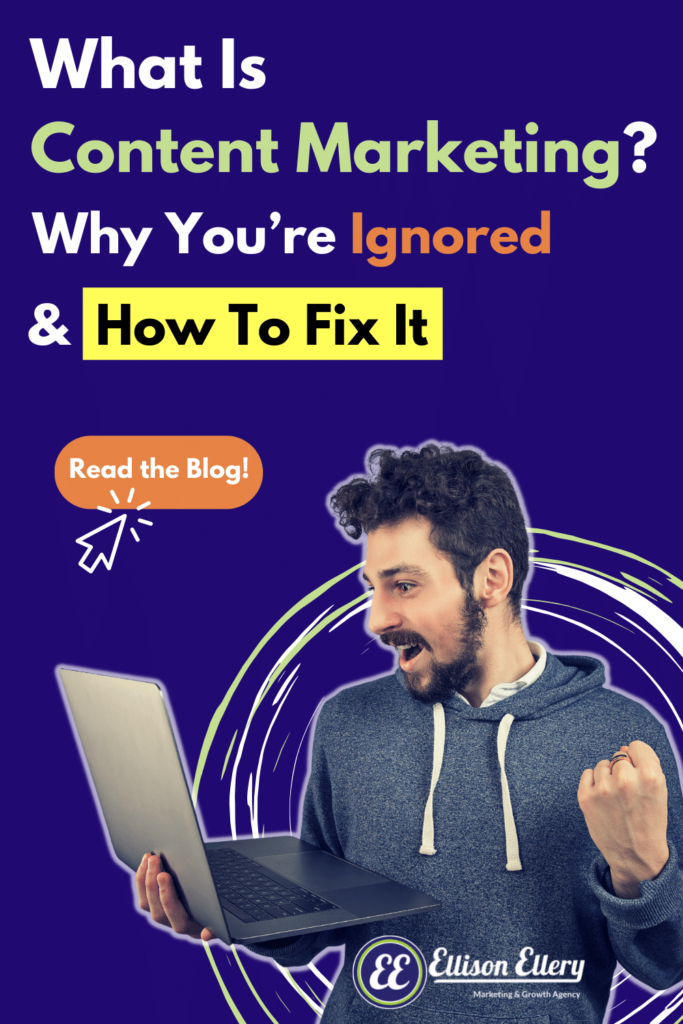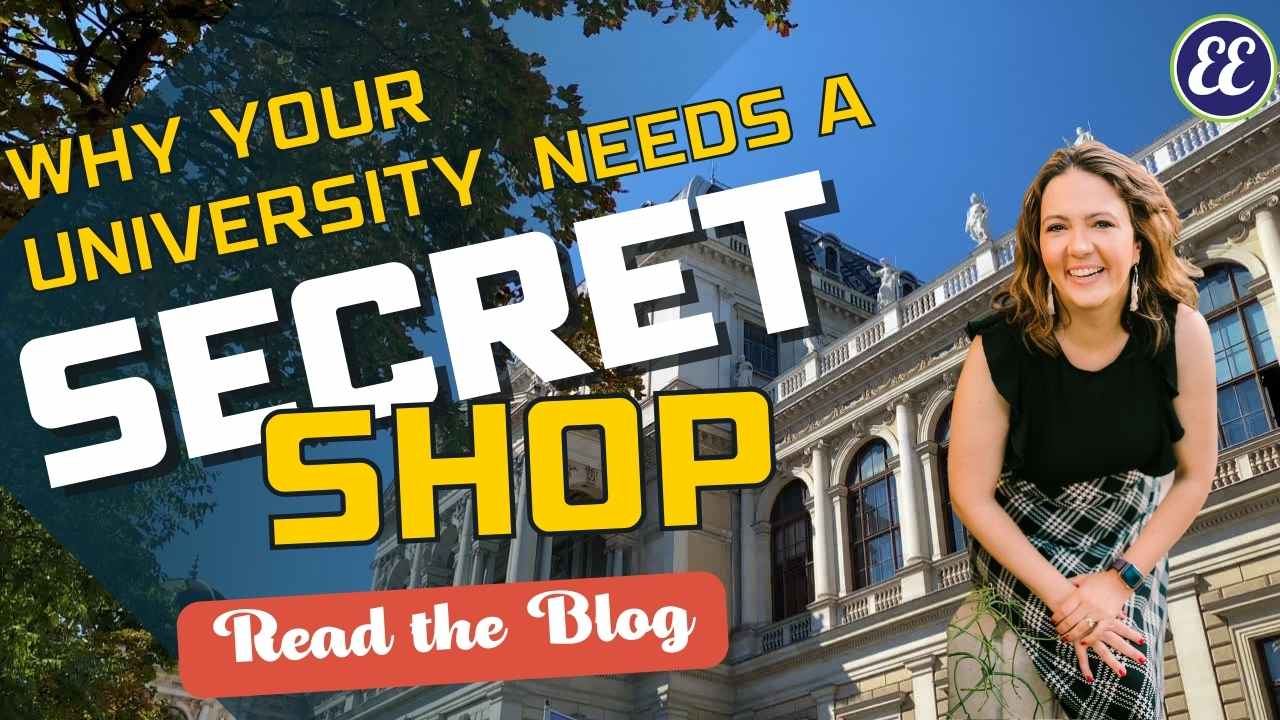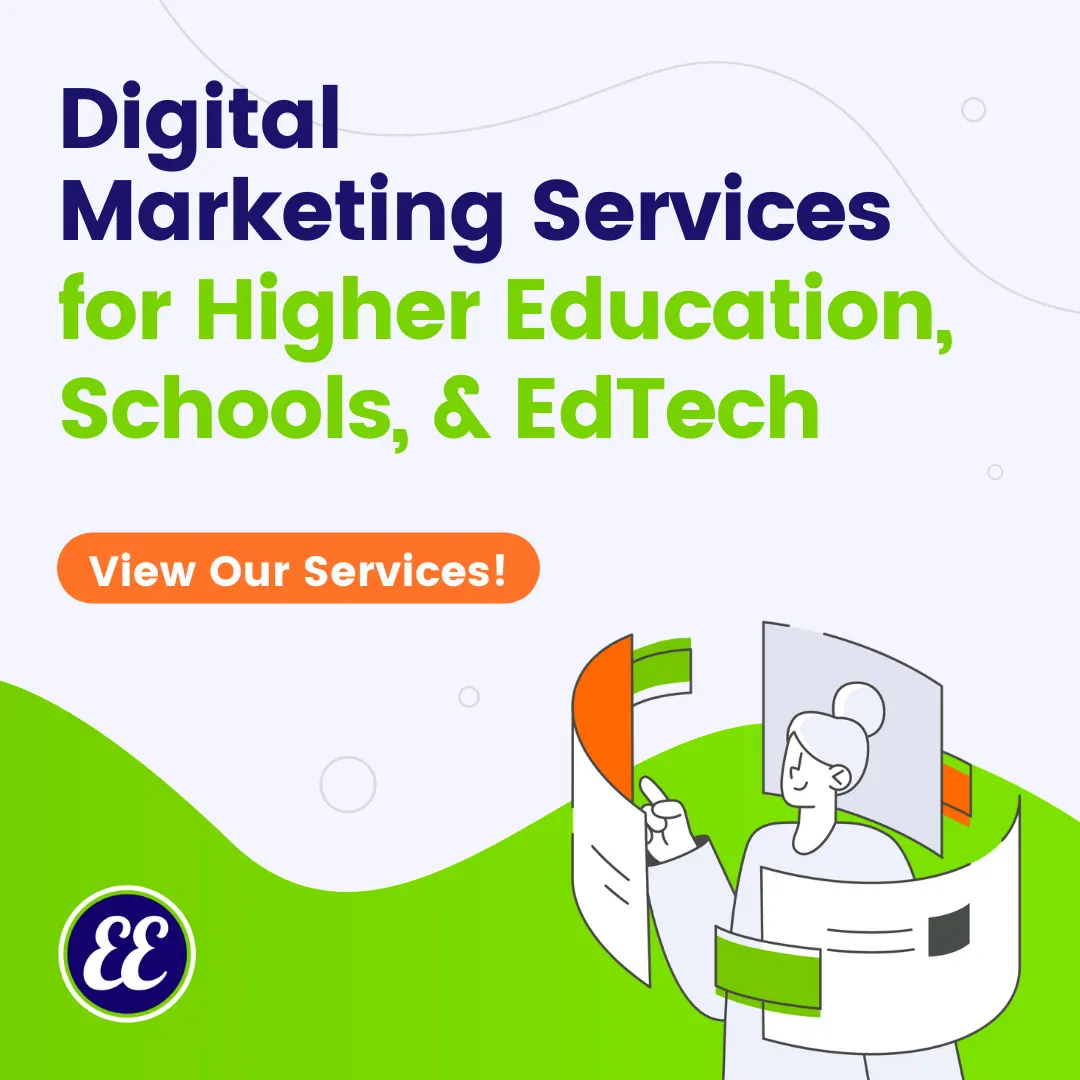Many businesses neglected content marketing in the past because it was difficult to measure the exact ROI. How many sales were influenced by your content? How many sales might you have otherwise lost?
However, the value is clear if you know where to look. And in fact, companies that have a content strategy grow 30% faster than those that don’t.
Buyers are now overrun with thousands of marketing messages each day, and marketers are being challenged to produce content that is not only descriptive of what they sell or do, but also provides value, entertains, and solves problems for consumers that they sometimes don’t even know they have.
If you want your business to grow, you have to learn how to build a unique approach that engages your ideal customers. You’ll be able to seamlessly guide leads—customers, clients, followers, students, or whoever it is you’re targeting—along the buyer’s journey and ultimately help your business thrive.
Table of Contents
Everything (And We Mean Everything) Needs To Come From Content Strategy
Did you know that nearly half of all buyers view 3 to 5 pieces of content before engaging with a sales representative?
Yup, that means your content does a lot of talking for your business or your program. Buyers now want to be self-directed and in control of the buying process. The wealth of information available to them before needing to talk to a salesperson (if they end up needing to at all) makes it possible for them to do so.
So when someone makes a purchasing decision, it’s safe to assume that they’re already familiar with your brand or your product in some way. This means that if your content isn’t driven by an understanding of your buyers’ pain points or what motivates them to buy, they won’t even stick around to give you the chance to show them.
If everything comes back to your content strategy, you’ll be able to:
- Create offers that work
- Align your teams
- Get your potential customers to see and understand exactly what you’re trying to say
The prettiest graphics and most technically flawless campaign won’t work if the offer doesn’t make any sense for your buyer. It has to make sense, it has to wow potential customers, and it has to be better than your competitors.
Consider Facebook ads– literally, 90% of Facebook ads are unsuccessful because they don’t use a strong offer. Your offer can be a piece of content like an ebook, but it has to be something that has a high perceived value for your audience.
And the best way to make sure your ads, copy, offers—everything— make sense and offer real value? Focusing everything around a powerful, deliberate content plan.
When they’re not, the resulting product is just random acts of marketing that don’t drive growth. We see it all the time as Fractional CMOs: the root of the problem is that everything isn’t connected by one strong content strategy.
Watch this Video to Learn More About Content Strategy
Making Sure Everything Comes From Your Content Strategy
Making sure that everything comes back to your content strategy isn’t just about creating successful ads. Here are some other places that can really suffer if they aren’t backed by your strategy:
- Your content strategy needs to bleed into your sales enablement plan to provide your sales team with relevant and powerful content that helps them close sales.
- Email marketing has some of the best ROI in marketing, but it won’t help your business grow if you’re not sending the right content through your messages.
- Your lead nurturing techniques won’t push your buyers through the sales funnel if you don’t understand their buyer motivations and keep them engaged with the proper content
Newsletter Sign up!
Get our best content on digital marketing in your inbox 2 times a month
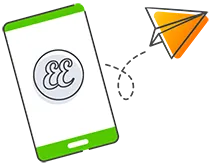
If content strategy isn’t the base holding everything together, every team member and every channel your organization uses won’t be aligned, and the final content you put out in each place will come across as disjointed.
Repurposing your content helps you stay consistent with your content strategy across the board. Start with pillar content that covers a lot— a long-form blog post (like this one!) or an ebook— and then start to repurpose it. Break it down into:
- Smaller, more niche blog posts
- Social media posts that you share on your various accounts
- A video
- Reels and mini-infographics
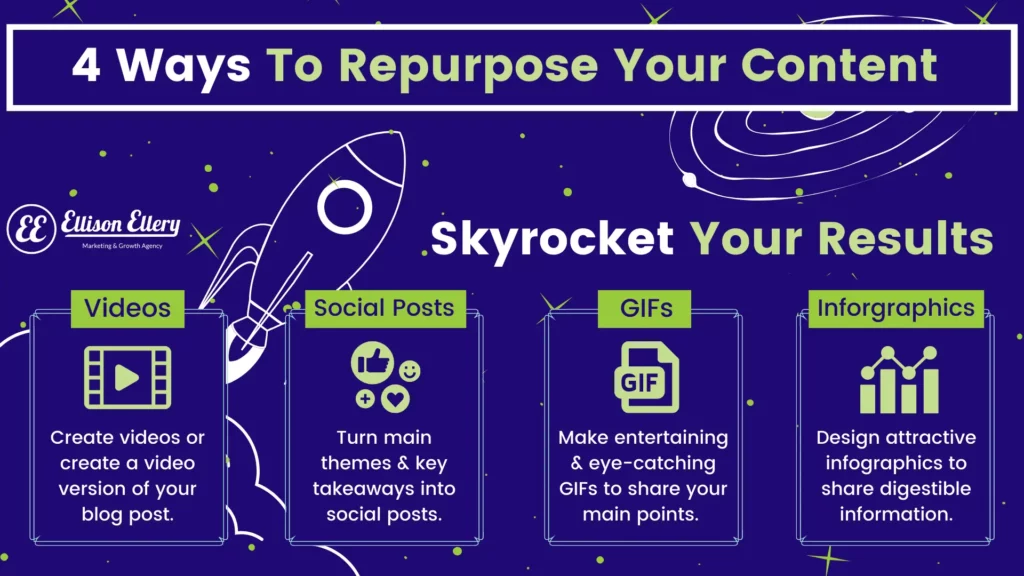
Not only will your messaging, tone, and information stay consistent across each platform, you’ll drive people back to the original content and keep them interested and engaged with you.
What Is Content Marketing?
Content marketing is the process of creating and distributing valuable content to your audience—including current, past, and prospective customers.
When you have a strong content marketing strategy in place, your organization is in a good strategic position to:
- Attract your ideal audience
- Retain current business
- Generate referrals
As marketers we often think content strategy is just driving new business, but it goes beyond that! It’s not just about getting customers’ eyes on what you have to offer— you have to make them want to buy in, stay around, and tell people all about you, too.
Content marketing is a major piece of your inbound marketing strategy, AKA anything you do that draws people to your business because they see your value and think that you can help solve their problems. (As opposed to proactively reaching out to people, or outbound marketing.)
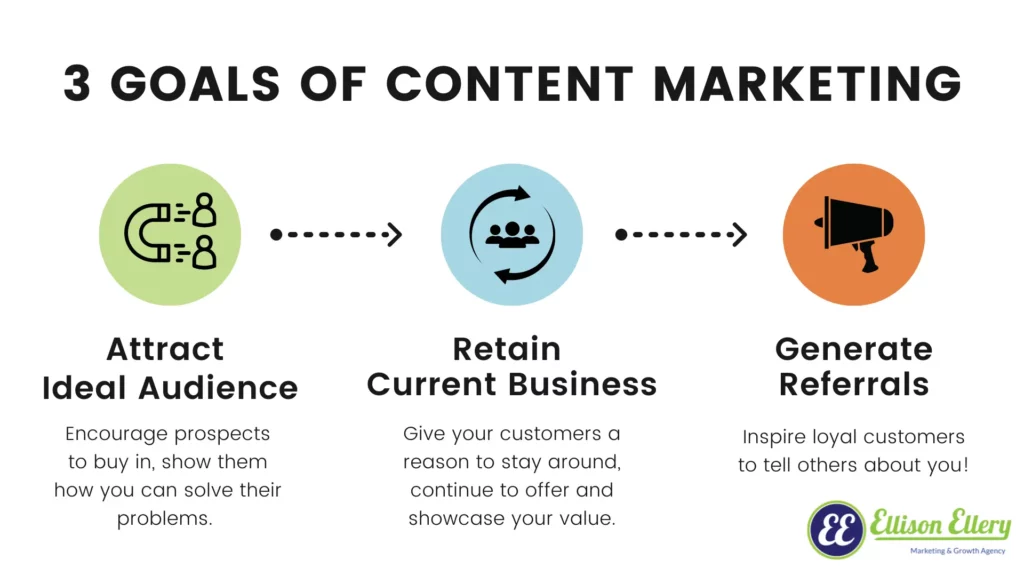
Putting the right content into the world helps to create valuable and relevant experiences for target customers, all while building connections and turning them from interested passersby to loyal customers.
The most common pieces of a content marketing strategy are:
- Blog posts
- Whitepapers and lead magnets
- Newsletters and emails
- Social media
- Videos
- Case studies
- Workbooks and e-books
“Content” doesn’t have to stop there, but you get the picture. There are a lot of options, and different types of content work better for different businesses. That’s why content marketing isn’t just about creating content—it’s about building (and testing, and rebuilding) a strategic plan for content that makes sense for a specific group of buyers.
A thorough content marketing strategy spans multiple different types of media as well. Use these inform how you structure and use content:
- Paid Media: You create content for these channels and pay for the space they take (Google Ads for example).
- Owned Media: This is the type of content that you create, distribute, and promote on your own (your website’s landing pages, a Youtube channel, blog posts, etc).
- Earned Media: This is any content that you don’t distribute yourself, like press and customer reviews. Even if you created the content (like a press release), you earned your audience’s attention via a channel other than your own.
It’s important to develop and execute your content marketing consistently. It helps establish and nurture relationships with current and potential buyers because it lets them know you’re there, shows them that you’re on their team, and positions you as a trustworthy, knowledgeable resource that can meet their needs.
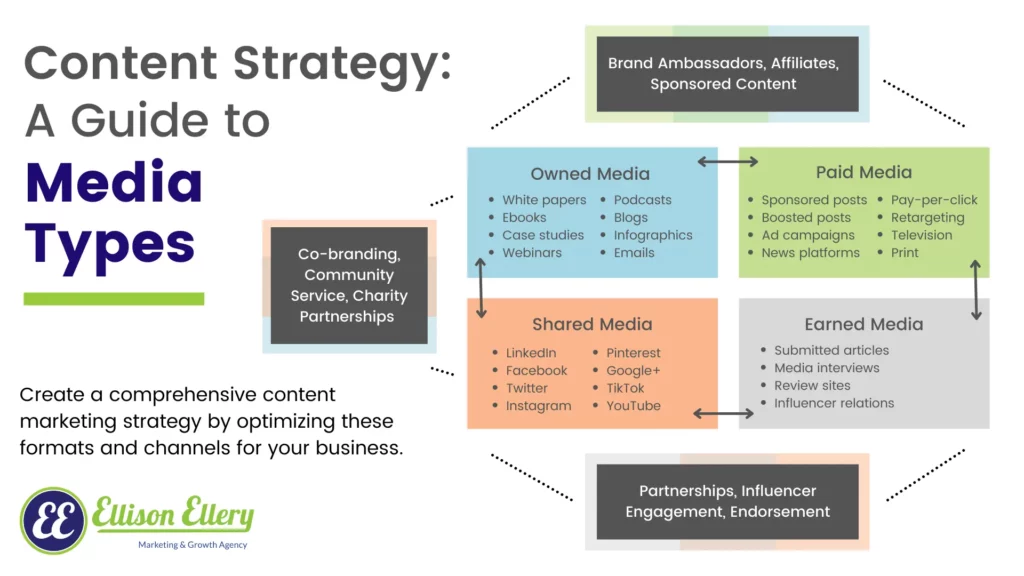
The Benefits of Content Marketing
What is content marketing all about? To put it simply, content marketing is important because it works. It’s been proven to help brands and businesses improve their results and stand out against competitors.
With the right strategy in place, you can make your content work for you and guide leads along the buyer’s journey.
That’s why content creation is a top priority for marketers and the portion of marketing budgets dedicated to content marketing is steadily growing.
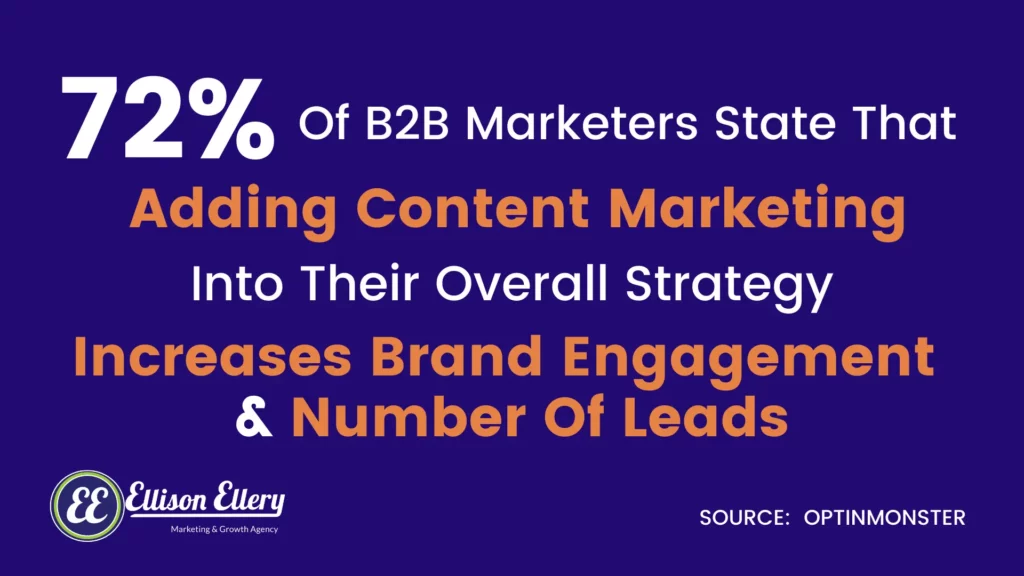
In fact, 72% of marketers (in B2B) state that consistently implementing content marketing into their strategy increases engagement with their brand and the number of leads that they generate.
Why does content marketing boost these brands’ credibility and value so much? Because the right content can:
- Build trust
- Provide value
- Help people visualize themselves in a situation
- Get the right people interested in a brand at the right time
- Generate more awareness
Keeping this in mind, let’s quickly take a look at the top benefits of content marketing. Then we’ll get into how to execute a content marketing strategy with the right channels so you can experience these awesome benefits too.
Generate Consistent Traffic & Become More Visible
If your buyers can’t find you, they can’t buy from you.
Obviously! 😉
And with an ever-growing number of businesses, products, and service providers, it’s far too easy to get lost in the crowd. Content marketing makes you visible, especially when it utilizes the right channels and proper techniques.
Consider the intersection of content marketing and search engine optimization. More than half of all website traffic comes from organic searches, but how do you rise to the top of the search results?
By creating relevant blog content or building landing pages with high-value offers, content marketing can help you do just that. This is exactly why you should be blogging for your business.
It’s not just about traffic from search engines though! If you add social media to your content marketing strategy, it can help you attract your ideal audience and keep them engaged with valuable and entertaining content.
Which in turn means more brand visibility and, hopefully, increased traffic to your website.
Content Marketing Makes Leads More Sales-Ready
Let’s say that you’re on the hunt for a new product—doing your online research as most people do before making a purchase these days—and you come across two companies that sell similar products.
One website has
- a series of blog posts showing the brand’s industry knowledge
- case studies with previous customer results
- testimonials
- a list of products with YouTube videos highlighting their features and benefits
The other website has a page listing the features of the product, and that’s it.
Which company are you probably going to be more interested in?
The first one!
Of course, not every prospect is ready to buy. Still, having content makes potential customers more sales-ready because they’ve interacted with your content, maybe read your blogs or followed you on social media. Now, when these people come across sales offers, they’ll be way more ready to give money because they’ve already established a connection to the brand.
(P.S. You may not even find the first company’s website to begin with because of its lack of content!)
Essentially, content marketing makes people more sales-ready because it:
- Creates value for buyers before they make a purchase
- Helps buyers visualize themselves using a product/service
- Establishes and grows a trusting relationship between buyers and sellers
Newsletter Sign up!
Get our best content on digital marketing in your inbox 2 times a month

Content Builds Trust and Authority
When it comes to running a successful business, school, organization, whatever it may be, building trust is essential. If your audience trusts you, they’ll be willing to extend their relationship with you and support your growth.
No one wants to give their money, time, or effort to someone or something that is likely to let them down!
This being said, it’s important to take steps to build and nurture the authority and trustworthiness of your brand. And you can do just that by creating content that:
- Answers your target audience’s questions
- Showcases your knowledge and expertise
- Uses case studies and testimonials for social proof
- Includes user-generated content
- Use storytelling in your content strategy
- Thought leadership from your CEO and subject matter experts
With these types of content, your audience sees your knowledge and experience and values your authority. User-generated content also shows prospects that their peers have already used and enjoyed your product or service, so why shouldn’t they?
Defined Buyer’s Journey
Wouldn’t it be nice if you could tell someone once about an offer and convince them to make a purchasing decision?
The reality is that you have to nurture leads through a series of stages before they become sales ready. And in order to do that, you have to understand your target audience on a really deep level… you can’t just keep guessing what will keep them engaged.
Content marketing relies on understanding your audience. Providing the right content at the right time can attract leads and make a case for why someone should be interested in you.
When creating a content marketing strategy, let the buyer’s journey inform which type of content you should create. In turn, each stage in the buyer’s journey has to be supported by content that pushes a consumer along the road from lead to loyal customer.
- Awareness Stage: Top of the funnel content should always focus on pain points, challenges, and questions that are engaging and informative. Your main goal in using content is to drive traffic. Some examples are blog posts, videos, lead magnets.
- Consideration Stage: A middle of the funnel buyer is looking for solutions and comparing options to solve a problem they’ve identified. You want to educate readers on what to look for (and throw your name in the ring). Think along the lines of webinars, case studies, social proof.
- Decision Stage: Content to help close the sale—focus on your expertise and why you’re the best choice, not just what you sell. Now is the time for demos and case studies.
- Retention Stage: Encourage your customer to stay around. The focus here is building loyalty through exclusive content, consistent value, and other more personalized lead nurture techniques.
Consumers want personalized experiences that offer insane amounts of value. Content marketing can help you build a focused sales enablement plan, so you deliver that value to consumers at the right time, while also connecting with them on a deeper level.
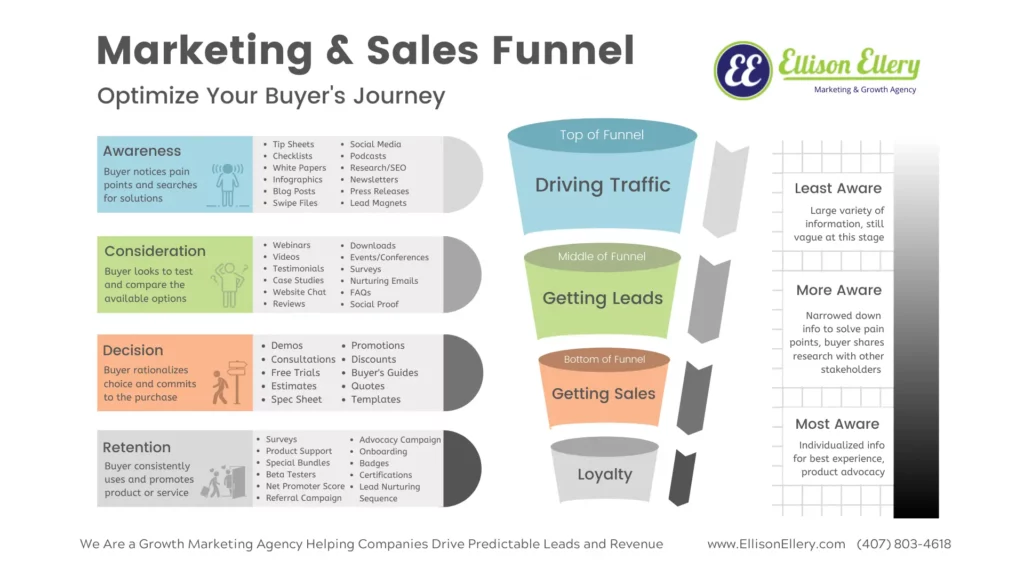
Building And Executing Your Content Strategy
If we haven’t drilled it home yet, good content is about much more than a killer font or cool visuals. Begin building your brand’s content strategy by asking these essential questions:
Who Is Your Target Audience?
In order to build out content that attracts the right audience, you have to know who they are. Instead of just thinking about your product/service in terms of what it is, think about what challenges it solves and for who. Build out 1 or 2 personas, or example personalities of those who can benefit from reading your content. What are your ideal buyer’s:
- Priorities
- Challenges and pain points
- Preferences
- Goals
Who is your ideal audience? What do they really want? Oftentimes, the reasons we give others to explain our purchases aren’t the ones that matter. Take the time to think about what truly motivates them to buy.
Grammarly is a great example of focusing on desires, not issues—they present their product as a way to avoid grammar mistakes and thus communicate more professionally.
The problem was never the misused comma in the email. The problem was how that comma might be perceived by your boss. If you can identify which fears or anxieties drive your customers to make a purchase, you can then create content that tells the story of how to make that problem disappear. Using your product, of course.
What Makes You Unique?
Don’t just ask what you do, ask why you do it and how it’s different from your competitors. Make this a major focus of your content marketing so that you can drive home the point that no one else can give what you have to offer.
What Is Your Buyer’s Journey?
Buyers will likely explore a variety of different options before they begin looking for a solution like yours. So, it’s important to think about all stages of the buyer’s journey when building out your strategy so you can capture interest at various points of this journey and nurture them the rest of the way to a sale.
What content can you use to show a consumer you can solve their problem before they’re actively looking to solve it? What can you use to stand out as the solution once they do look for a solution? And last but not least, what can you do to make sure they keep coming back?
The answers to these questions are crucial for developing content that sells; use this content to create a sales enablement plan that makes it easy for your sales team to reach buyers where they are and inspire them to take action.
Using SEO To Build A Content Strategy
Did you know that 68% of online experiences begin with a search engine? That’s a pretty strong reason to prove that you need to try and get onto page one of the search results (75% of users don’t go past this page).
But, page one of the search results won’t really matter unless the content on page one is helping you bring in the right people. You have to merge your SEO efforts with your content strategy, which is something many B2B companies fail to do. In fact, 76% of companies spend their budgets targeting the wrong keywords for B2B SEO.
AKA, they’re spending valuable marketing dollars targeting keywords that their target audience isn’t even searching.
SEO helps you build a stronger content strategy. Through keyword research, you’ll be able to learn more about what your potential customers are searching. You’ll get insights into the topics that your content needs to focus on to attract those who matter.
SEO is way more cost-efficient than paid advertising alone and although it can’t replace paid advertising entirely, it’s an added strategy to help your business bring in the right prospects.

Executing Your Content Strategy
So you’ve got content. Now where do you put it? Remember, every piece of content needs a clear purpose and should be centered around creating irresistible offers for your prospective buyers.
Let’s take a look at some of the avenues for executing your content marketing strategy and how you can use them.
Is Blogging Important For Content Strategy?
Blogging is one of the most important things you can do for a content strategy, no matter who you are. There are a few reasons for that.
Earlier we said that a major benefit of content marketing was that it helps drive traffic to your website via organic search. Especially with blogging, it helps a lot! Businesses that blog get 55% more website visitors than businesses who don’t.
Simply put, more great content = more traffic to your website. According to Hubspot, companies with blogs have 434% more indexed pages than businesses without blogs, which helps your website rank even higher.
Outside of generating traffic, including blog content in your content marketing strategy is a great way to build trust and authority with your audience. Don’t just show off your services (although you should make sure you do that too!), show them that you know what you’re talking about and that you understand their pain points.
Blogs are great for establishing the basis for your content strategy, and you can repurpose those blog posts into even more content and ideas.
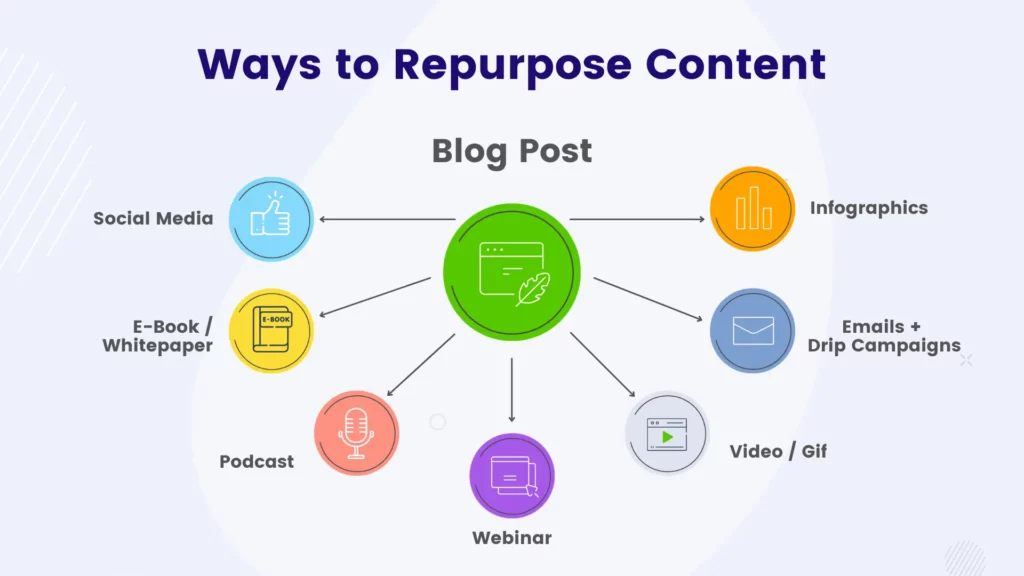
Video Content Marketing
We probably don’t have to tell you that video has become one of the most popular content mediums. People watch over 1 billion hours of video on YouTube every day. If that’s not an indication that many people prefer consuming content through video, we don’t know what is!
Investing in video content may seem like a lot of work, but it’s worth it. Here are some stats about video marketing to know:
- Video on landing pages can increase conversions by 80%
- Customers are up to 84% more likely to make a purchase after watching a product video
- Video can improve your ranking in search results—including multiple types of media indicates to Google that your website is informative
- A marketing video can attract up to 300% more traffic and leads.
- Video-based social media posts generate 48% more views.
- Emails with video have a 300% higher click rate.
- If a webpage has textual and visual content, 72% of viewers will prefer watching the video to understand a product or service. (HubSpot)
There’s a reason that video formatted posts on social media are taking off like wildfire. Videos, especially short-form videos like TikTok and Instagram Reels, are extremely bingeable and perfectly designed to be both informative and entertaining, breeding a new type of video edutainment.
Use content marketing to take your audience behind the scenes or walk them through your services/products. It’s a great way to build trust and credibility.
Creating Content For Social Media Platforms
Social media and content marketing go hand in hand, there’s really no way around it! But how exactly do you craft an effective social media content strategy?
We want you to think about social media in your content strategy in two ways:
- You have content (e.g. blogs), now spread the word about it on social media.
- Creating content specifically for your social media platforms.
Both of these avenues require you to understand who you’re targeting with your product/service, the different stages your customer experiences during their journey to conversion, and how they want to consume your content and offers.
In general, here are some tips for a content strategy on social media:
Focus On Channels With Potential
We’re not saying that you can’t have multiple different social media accounts or that you shouldn’t experiment with your options. However, especially if you’re just starting to build out a content strategy, it’s a very good idea to focus on the ones that are going to help you.
Plus, if you don’t have the bandwidth to put the right attention and care into your social content, it won’t only waste your time—it might hurt your brand too.
Figure out what channels your target audience are spending their time on and focus your efforts there.
Diversify Content By Social Channels
Ah, if only things could be simple right? Well, a solid content strategy with a brand tone based on an understanding of your audience can certainly help with this…but not all social media channels are created equal.
Switch up your copy to match each channel and use formats that perform best on them. For example, the video format is not a one-size-fits-all situation:
- Twitter only allows native posting of videos that are 2:20 or shorter.
- LinkedIn’s native videos can be up to 10 minutes long unless it’s a video ad, which can be 30 minutes.
- Facebook’s videos can be up to 4 hours long
When you take these differences into consideration, combined with knowledge of how users interact with content on certain platforms, your resulting content strategy might look different on each platform.
Test, Modify, and Test Again
We wish we had all of the answers for you. Heck, we wish we had all of the answers for ourselves!
But the name of the game when it comes to social media is testing and trying again. Of course, everything should be backed and informed by your content strategy. But social media trends and tools are always changing and you have to be prepared for this to happen.
Try things out, analyze the results, and modify as needed from there in order to improve and grow.

How To Repurpose Content (You’re Gonna Want To Know This One)
By now you know that publishing quality content is great for all sorts of objectives, from building brand awareness to generating high-quality leads that convert. As important as it is, it can be hard to create content each and every day that resonates with your audience and covers all of the places they like to consume their content.
Other than honing in on a targeted content strategy specific to your brand’s purpose and goals, knowing how to repurpose content can save you a lot of headaches. Take one piece of content, like a long-form blog for example, and repurpose it into new formats across many channels.
Repurposing your long-form blog posts has two major benefits:
- What you say in your content and how you say it will be consistent everywhere you show up
- You increase your web presence making it easier for people to find your content
Pull out major points, key takeaways, smaller niche topics, and other “bite-size” pieces of information from a larger piece of content, then brainstorm the different ways you can represent these ideas in other media formats.
- Turn statistics into Instagram posts or LinkedIn carousels.
- Call out interesting quotes.
- Highlight rave reviews.
- Create stories, reels, and promo videos to help leverage and amplify your long-form content
- The possibilities are endless!
Discover How Ellison Ellery Can Help You Drive More ROI Through Content Marketing
So in summary, what is content marketing?
Content marketing is the basis of your digital marketing that ensures you target the right people, with the right content, at the right time. We hope that this post inspired you to build a content strategy and base everything you do around it. Every stage of a content marketing strategy—from understanding buyer personas to knowing which channels to use—is critical for creating sustainable growth.
Need help? That’s where we come in. We can help you build out a strong content marketing strategy and create content that converts. Head on over to our marketing page to see our full list of services, then schedule a free marketing consultation with us to get started.
